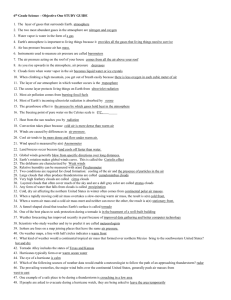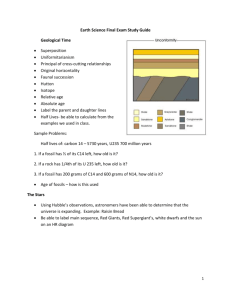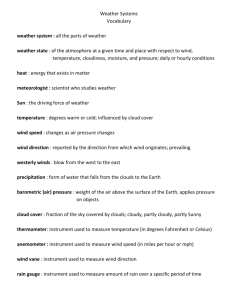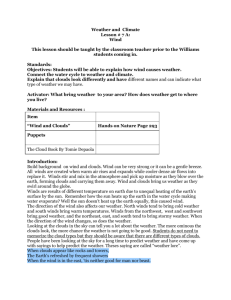File
advertisement
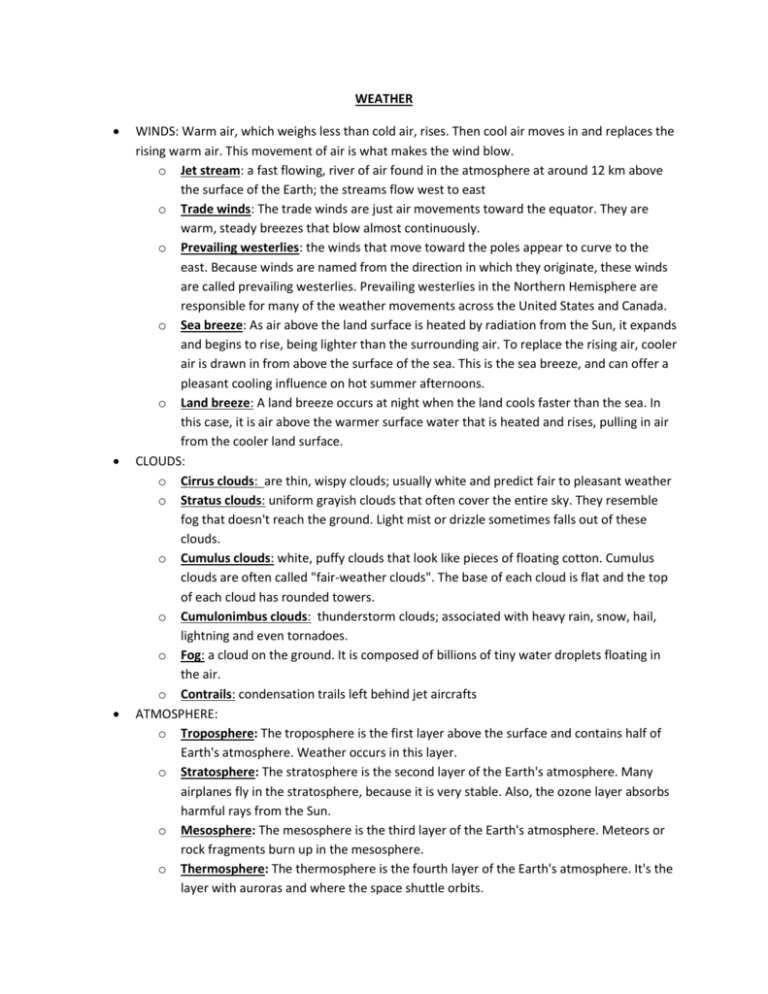
WEATHER WINDS: Warm air, which weighs less than cold air, rises. Then cool air moves in and replaces the rising warm air. This movement of air is what makes the wind blow. o Jet stream: a fast flowing, river of air found in the atmosphere at around 12 km above the surface of the Earth; the streams flow west to east o Trade winds: The trade winds are just air movements toward the equator. They are warm, steady breezes that blow almost continuously. o Prevailing westerlies: the winds that move toward the poles appear to curve to the east. Because winds are named from the direction in which they originate, these winds are called prevailing westerlies. Prevailing westerlies in the Northern Hemisphere are responsible for many of the weather movements across the United States and Canada. o Sea breeze: As air above the land surface is heated by radiation from the Sun, it expands and begins to rise, being lighter than the surrounding air. To replace the rising air, cooler air is drawn in from above the surface of the sea. This is the sea breeze, and can offer a pleasant cooling influence on hot summer afternoons. o Land breeze: A land breeze occurs at night when the land cools faster than the sea. In this case, it is air above the warmer surface water that is heated and rises, pulling in air from the cooler land surface. CLOUDS: o Cirrus clouds: are thin, wispy clouds; usually white and predict fair to pleasant weather o Stratus clouds: uniform grayish clouds that often cover the entire sky. They resemble fog that doesn't reach the ground. Light mist or drizzle sometimes falls out of these clouds. o Cumulus clouds: white, puffy clouds that look like pieces of floating cotton. Cumulus clouds are often called "fair-weather clouds". The base of each cloud is flat and the top of each cloud has rounded towers. o Cumulonimbus clouds: thunderstorm clouds; associated with heavy rain, snow, hail, lightning and even tornadoes. o Fog: a cloud on the ground. It is composed of billions of tiny water droplets floating in the air. o Contrails: condensation trails left behind jet aircrafts ATMOSPHERE: o Troposphere: The troposphere is the first layer above the surface and contains half of Earth's atmosphere. Weather occurs in this layer. o Stratosphere: The stratosphere is the second layer of the Earth's atmosphere. Many airplanes fly in the stratosphere, because it is very stable. Also, the ozone layer absorbs harmful rays from the Sun. o Mesosphere: The mesosphere is the third layer of the Earth's atmosphere. Meteors or rock fragments burn up in the mesosphere. o Thermosphere: The thermosphere is the fourth layer of the Earth's atmosphere. It's the layer with auroras and where the space shuttle orbits. o Exosphere: The exosphere is the fifth and last layer of the Earth's atmosphere. This is the layer where the atmosphere merges into space. This layer is extremely thin. FORECASTING o High pressure system: a whirling mass of cool, dry air that generally brings fair weather and light winds. o Low pressure system: a whirling mass of warm, moist air that generally brings stormy weather with strong winds. o Cold front: the colder air replaces the warmer air o Warm front: the warmer air replaces the cooler air INSTRUMENTS o Barometer: measures air pressure o Rain gauge: measures the amount of rain that has fallen over a specific time period. o Wind vane: determines the direction from which the wind is blowing. o Anemometer: measures wind speed o Weather balloon: measures weather conditions higher up in the atmosphere. WATER CYCLE o Evaporation: when the sun heats up water in rivers or lakes or the ocean and turns it into vapor or steam. The water vapor or steam leaves the river, lake or ocean and goes into the air. o Condensation: Water vapor in the air gets cold and changes back into liquid, forming clouds o Precipitation: occurs when so much water has condensed that the air cannot hold it anymore. The clouds get heavy and water falls back to the earth in the form of rain, hail, sleet or snow. o Collection: When water falls back to earth as precipitation, it may fall back in the oceans, lakes or rivers or it may end up on land. When it ends up on land, it will either soak into the earth and become part of the “ground water” that plants and animals use to drink or it may run over the soil and collect in the oceans, lakes or rivers where the cycle starts all over again. REMEMBER o Land heats up before water o Temperatures are hotter at the equator because it is exposed to more direct sunlight (tilt of the earth); the farther from the equator, the cooler the temperatures o Wind is created by the heating and cooling rates of soil and water o The higher the elevation (distance above sea level) the cooler the temperature o Thin air holds less heat, expect cold temperatures o Our sun is mostly responsible for our weather

